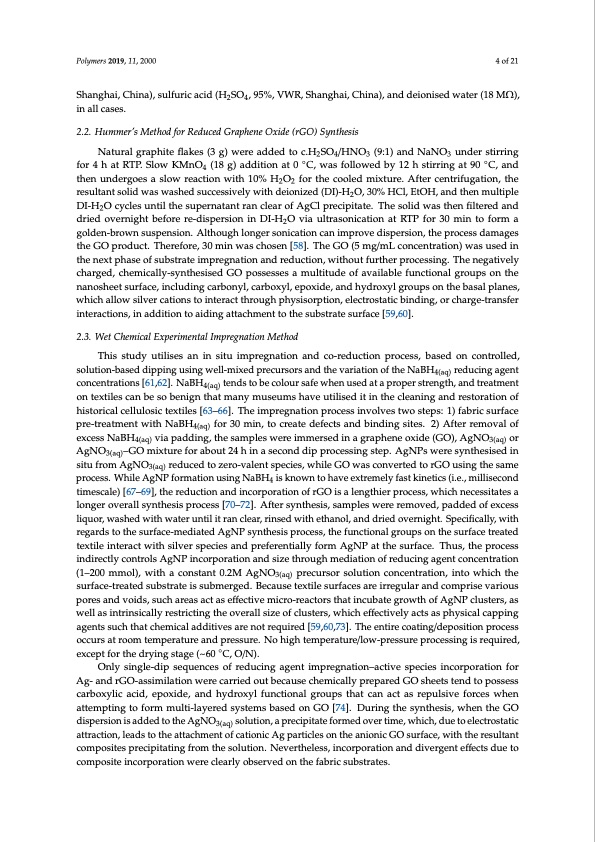
PDF Publication Title:
Text from PDF Page: 004
Polymers 2019, 11, 2000 4 of 21 Shanghai, China), sulfuric acid (H2SO4, 95%, VWR, Shanghai, China), and deionised water (18 MΩ), in all cases. 2.2. Hummer’s Method for Reduced Graphene Oxide (rGO) Synthesis Natural graphite flakes (3 g) were added to c.H2SO4/HNO3 (9:1) and NaNO3 under stirring for 4 h at RTP. Slow KMnO4 (18 g) addition at 0 ◦C, was followed by 12 h stirring at 90 ◦C, and then undergoes a slow reaction with 10% H2O2 for the cooled mixture. After centrifugation, the resultant solid was washed successively with deionized (DI)-H2O, 30% HCl, EtOH, and then multiple DI-H2O cycles until the supernatant ran clear of AgCl precipitate. The solid was then filtered and dried overnight before re-dispersion in DI-H2O via ultrasonication at RTP for 30 min to form a golden-brown suspension. Although longer sonication can improve dispersion, the process damages the GO product. Therefore, 30 min was chosen [58]. The GO (5 mg/mL concentration) was used in the next phase of substrate impregnation and reduction, without further processing. The negatively charged, chemically-synthesised GO possesses a multitude of available functional groups on the nanosheet surface, including carbonyl, carboxyl, epoxide, and hydroxyl groups on the basal planes, which allow silver cations to interact through physisorption, electrostatic binding, or charge-transfer interactions, in addition to aiding attachment to the substrate surface [59,60]. 2.3. Wet Chemical Experimental Impregnation Method This study utilises an in situ impregnation and co-reduction process, based on controlled, solution-based dipping using well-mixed precursors and the variation of the NaBH4(aq) reducing agent concentrations [61,62]. NaBH4(aq) tends to be colour safe when used at a proper strength, and treatment on textiles can be so benign that many museums have utilised it in the cleaning and restoration of historical cellulosic textiles [63–66]. The impregnation process involves two steps: 1) fabric surface pre-treatment with NaBH4(aq) for 30 min, to create defects and binding sites. 2) After removal of excess NaBH4(aq) via padding, the samples were immersed in a graphene oxide (GO), AgNO3(aq) or AgNO3(aq)–GO mixture for about 24 h in a second dip processing step. AgNPs were synthesised in situ from AgNO3(aq) reduced to zero-valent species, while GO was converted to rGO using the same process. While AgNP formation using NaBH4 is known to have extremely fast kinetics (i.e., millisecond timescale) [67–69], the reduction and incorporation of rGO is a lengthier process, which necessitates a longer overall synthesis process [70–72]. After synthesis, samples were removed, padded of excess liquor, washed with water until it ran clear, rinsed with ethanol, and dried overnight. Specifically, with regards to the surface-mediated AgNP synthesis process, the functional groups on the surface treated textile interact with silver species and preferentially form AgNP at the surface. Thus, the process indirectly controls AgNP incorporation and size through mediation of reducing agent concentration (1–200 mmol), with a constant 0.2M AgNO3(aq) precursor solution concentration, into which the surface-treated substrate is submerged. Because textile surfaces are irregular and comprise various pores and voids, such areas act as effective micro-reactors that incubate growth of AgNP clusters, as well as intrinsically restricting the overall size of clusters, which effectively acts as physical capping agents such that chemical additives are not required [59,60,73]. The entire coating/deposition process occurs at room temperature and pressure. No high temperature/low-pressure processing is required, except for the drying stage (~60 ◦C, O/N). Only single-dip sequences of reducing agent impregnation–active species incorporation for Ag- and rGO-assimilation were carried out because chemically prepared GO sheets tend to possess carboxylic acid, epoxide, and hydroxyl functional groups that can act as repulsive forces when attempting to form multi-layered systems based on GO [74]. During the synthesis, when the GO dispersion is added to the AgNO3(aq) solution, a precipitate formed over time, which, due to electrostatic attraction, leads to the attachment of cationic Ag particles on the anionic GO surface, with the resultant composites precipitating from the solution. Nevertheless, incorporation and divergent effects due to composite incorporation were clearly observed on the fabric substrates.PDF Image | Antimicrobial from Silver-Graphene Coated Medical Textiles

PDF Search Title:
Antimicrobial from Silver-Graphene Coated Medical TextilesOriginal File Name Searched:
polymers-11-02000-v2.pdfDIY PDF Search: Google It | Yahoo | Bing
Turbine and System Plans CAD CAM: Special for this month, any plans are $10,000 for complete Cad/Cam blueprints. License is for one build. Try before you buy a production license. More Info
Waste Heat Power Technology: Organic Rankine Cycle uses waste heat to make electricity, shaft horsepower and cooling. More Info
All Turbine and System Products: Infinity Turbine ORD systems, turbine generator sets, build plans and more to use your waste heat from 30C to 100C. More Info
CO2 Phase Change Demonstrator: CO2 goes supercritical at 30 C. This is a experimental platform which you can use to demonstrate phase change with low heat. Includes integration area for small CO2 turbine, static generator, and more. This can also be used for a GTL Gas to Liquids experimental platform. More Info
Introducing the Infinity Turbine Products Infinity Turbine develops and builds systems for making power from waste heat. It also is working on innovative strategies for storing, making, and deploying energy. More Info
Need Strategy? Use our Consulting and analyst services Infinity Turbine LLC is pleased to announce its consulting and analyst services. We have worked in the renewable energy industry as a researcher, developing sales and markets, along with may inventions and innovations. More Info
Made in USA with Global Energy Millennial Web Engine These pages were made with the Global Energy Web PDF Engine using Filemaker (Claris) software.
Infinity Turbine Developing Spinning Disc Reactor SDR or Spinning Disc Reactors reduce processing time for liquid production of Silver Nanoparticles.
| CONTACT TEL: 608-238-6001 Email: greg@infinityturbine.com | RSS | AMP |